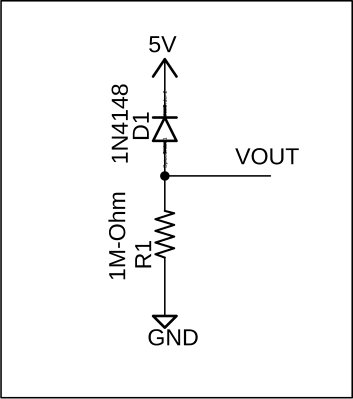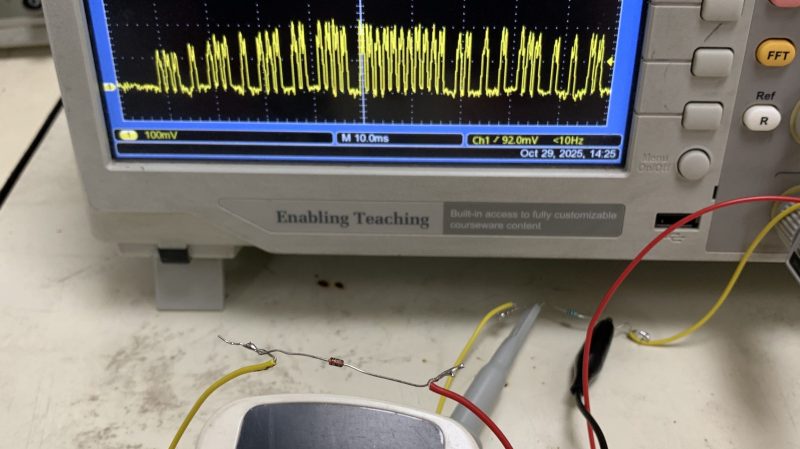[Dhananjay Gadre] happened across a useful little trick the other day. Take any old 1N4148 or 1N914 glass-package signal diode and wire it up right, and you’ve got yourself a nifty little IR detector.

The trick is to treat the diode just like you would a proper IR photodiode. The part should be reverse biased with a resistor inline, and the signal taken from the anode side. Point an IR remote at your little diode and you’ll readily see the modulated signal pop up on a scope, clear as day.
The phenomenon is discussed at length over on Stack Exchange. Indeed, it’s a simple fact that most semiconductor devices are subject to some sort of photoelectric effect or another. It’s just that we stick the majority of them in opaque black packages so it never comes up in practice. In reality, things like photodiodes and phototransistors aren’t especially different from the regular parts—they’re just put in transparent packages and engineered and calibrated to give predictable responses when used in such a way.
Is this the way you’d go if your project needed an IR detector? Probably not—you’d be better served buying the specific parts you need from the outset. But, if you find yourself in a pinch, and you really need to detect some IR signals and all you’ve got on hand is glass-package signal diodes? Yeah, you can probably get it to work.
While this trick is well known to many oldheads, it’s often a lightbulb moment for many up-and-coming engineers and makers to realize this. Glass-packaged diodes aren’t the only light-sensitive parts out there, either. As we’ve explored previously, certain revisions of Raspberry Pi would reboot if exposed to a camera flash, while you can even use regular old LEDs as sensors if you’re so inclined. If you’ve got your own secret knowledge about how to repurpose regular components in weird ways, don’t hesitate to notify the tipsline!
















Back in the CRT monitor days we had a particularly tricky repair at the depot. This unit worked fine until the cover was slid on. First guesses were some sort of bending of the main board and a questionable solder joint, but we couldn’t find one. Then we noticed the shadow of a hand passing over one section of the circuit board would cause the failure. Ended up being a glass zener diode in a voltage regulator changing value when dark.
Oof! I remember an old repair technician article from decades ago where the TV would work fine when the technician was looking at it, and fail when he wasn’t. He took a picture of his face and stuck it inside the case looking at the PCB and the TV started working consistently.
Apart from the obvious “written for amusement purposes rather than factual accuracy” thing, having a light sensitive component’s behaviour change because the paper covered a case hole would also be a potential explanation.
Reminds me of a Light Activated SCR that I got from Radio Shack in the 70’s. It was just a normal SCR in a metal can with the top sawn off, and potted.
Hehe yep and they called them LASCRs and they found use in photographic flash “slaves” which triggered when the main camera flash went off.
Reminds me of the striking voltage of neon lamps changing with exposure to light.
Fun effect, I have one in a switched spur which only lights when a finger comes close to it, once lit it stays lit.
Wonder where that bag of neons went and it I can waste a few hours playing^h^h^h^h^h^h^h experimentally determining the threshold voltage to make a presence detector
So why are 1N4148s etc packaged in glass? Is glass really cheaper than the opaque black stuff small signal transistors are packaged in?
Glass is hermetically sealed and can withstand higher operating temperatures. Gases like oxygen and water can diffuse through plastics, which could degrade the performance of the diode over time. Another reason is that the thermal expansion rate of glass is closer to the silicon material, so there’s less internal stresses which could affect the properties of the diode.
We discovered this effect back in the 90s when 2x inverse parallel 1N914s used to protect the input of a thermocouple amplifier created an accidental photo amplifier. Worked normally when the case was shut but gave no end of trouble under the glare of the flouro lamps on the work bench.
Oh brother, that sounds particularly annoying…!
I’ve seen similar protection schemes on analog meter movements. They’re almost always in an enclosure, so I’ve not yet experienced any measurement abnormalities. But thanks for mentioning the antiparallel diodes issue you saw, because I have an upcoming project involving analog meters where this very phenomenon might cause problems.
I used to work with a guy from German Democratic Republic (communist East Germany.)
He said that all integrated circuits made in the Soviet Union had problems with light.
ICs are normally enclosed in a light proof epoxy to prevent photoelectric effects from messing with the circuitry.
Whatever home-grown epoxy they used in the Soviet Union wasn’t sufficiently light proof.
Exposing pretty much any device made with such ICs to sunlight would cause the circuit to misbehave.
He had had a Soviet made pocket calculator that worked fine indoors, but which produced garbage and locked up when used outdoors on a sunny day – despite having the calculator housing covering the ICs.
Might be a Bill Meara story, but I remember hearing or reading of a military radio net where one station had mains hum on transmissions, turned out to be photoelectric effect in one or more of the valves (tubes, thermatrons etc ) picking up the station lighting. Covering the TX fixed it
Will audiophiles and astronomers unite to from a movement to fight urban light pollution? 🤔Seriously: is this not an issue for these nice looking tube amps?
Audophiles and pedophiles unite 💘
This reminds me of an incident at a steel rolling mill I visited years ago. An employee took a photo of an open control cabinet to document something. Instantly, the rolling mill stopped, resulting in a rather expensive production outage. The flash of the conventional camera had apparently triggered the light sensitivity of some component inside the open box.
Back in 2018 an old friend shared with me a troubleshooting story from South East Asia involving diodes and light: https://soldersmoke.blogspot.com/2018/02/a-wonderful-troubleshooting-story.html
Small signal diodes can also be used as temperature sensors. The resistance increases with increasing temperature in a fairly linear rate over a relatively narrow range.
Characteristic frequency of an LED can be changed by soaking it in superchilled urine. Makes for a nice party trick.
So many questions that I really don’t want to know the answers to
For just UV detection, the cost savings of use of UV diodes as UV photodiodes is especially beneficial.
“UV diodes” > “UV LEDS”
It’s not at all surprising that a glass-packaged diode suffers from the photoelectric effect…if you really want to blow my mind, do it with one of the plastic-packaged diodes that i actually have :)
This could have been a component abuse article.
It makes me think of anti-tamper and anti-reverse-engineering countermeasures for sensitive systems. Imagine engineering this into the voltage regulators so they foul up if they’re in the dark, and then having an LED connected on the far side of the PCB and routed by wires to near the diodes.